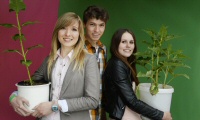Accept
Details & settings
This website uses cookies for cookie consent and statistics.
Rolf Hartmann, Ramona Pick, Laura Eschweiler

The sustainability strategy of the German government in form of the Renewable Energy Act aims to increase the fraction of renewable energy to 35% by 2020 and to 80% by 2050 [1]. This act became necessary due to growing global energy consumption and limited supplies of fossil fuels. Furthermore, the use of fossil fuels causes CO2 emissions that contribute to global warming. Renewable energy can address all of these challenges for future generations. In this context, we focused on sustainable raw materials.
Silage maize is currently the most important energy crop for producing biogas. However, this plant has a number of ecological disadvantages. It needs a lot of nutrients, pollutes the ground water through nitrate leaching [2], and contributes to erosion.
We investigate an alternative - Silphium perfoliatum. This is a perennial energy crop that reduces erosion by covering the ground throughout the year and it contributes to diversity as it can serve as a food source for bees [3]. Silphium perfoliatum originates from North America, but it can adapt to the German climate. It appears to be an undemanding plant as it can also be found in arid parts of North America. During the first year, it forms a leaf rosette on the ground. During the winter it freezes back and during the second year, it grows to a height of up to 3 meters with three to ten stems. Silphium perfoliatum is also known as cup plant, as pairs of its leafs form cups that collect dew around its stems. Additionally, its enormous root network is very effective at extracting humidity from the ground allowing it to grow below the agronomic dry boundary of about 500 mm rainfall per year. Furthermore, it needs fewer nutrients than maize. However, it is more expensive to grow during the first year and therefore the goal of our project is to minimize these costs.
Based on information from internet searches and a visit to a field trial in the strip mine Garzweiler, we conducted our own experiments to test the sustainability, efficiency and economic viability of Silphium perfoliatum. In order to be able to compare its growth to maize, we ordered a few seedlings during spring 2013 and grew them in our own field trial, in experimental planters and in flower pots under different conditions. We also conducted germination experiments.
[1] http://www.erneuerbare-energien.de/fileadmin/ee-import/files/pdfs/allgemein/application/pdf/eeg_2012_bf.pdf, 06.05.13, 15:06
[2] http://www.umweltbundesamt.de/sites/default/files/medien/publikation/long/3642.pdf, 06.05.2013, 16:20
[3] http://www.tll.de/ainfo/pdf/silp0810.pdf, 6.12.13,12:20